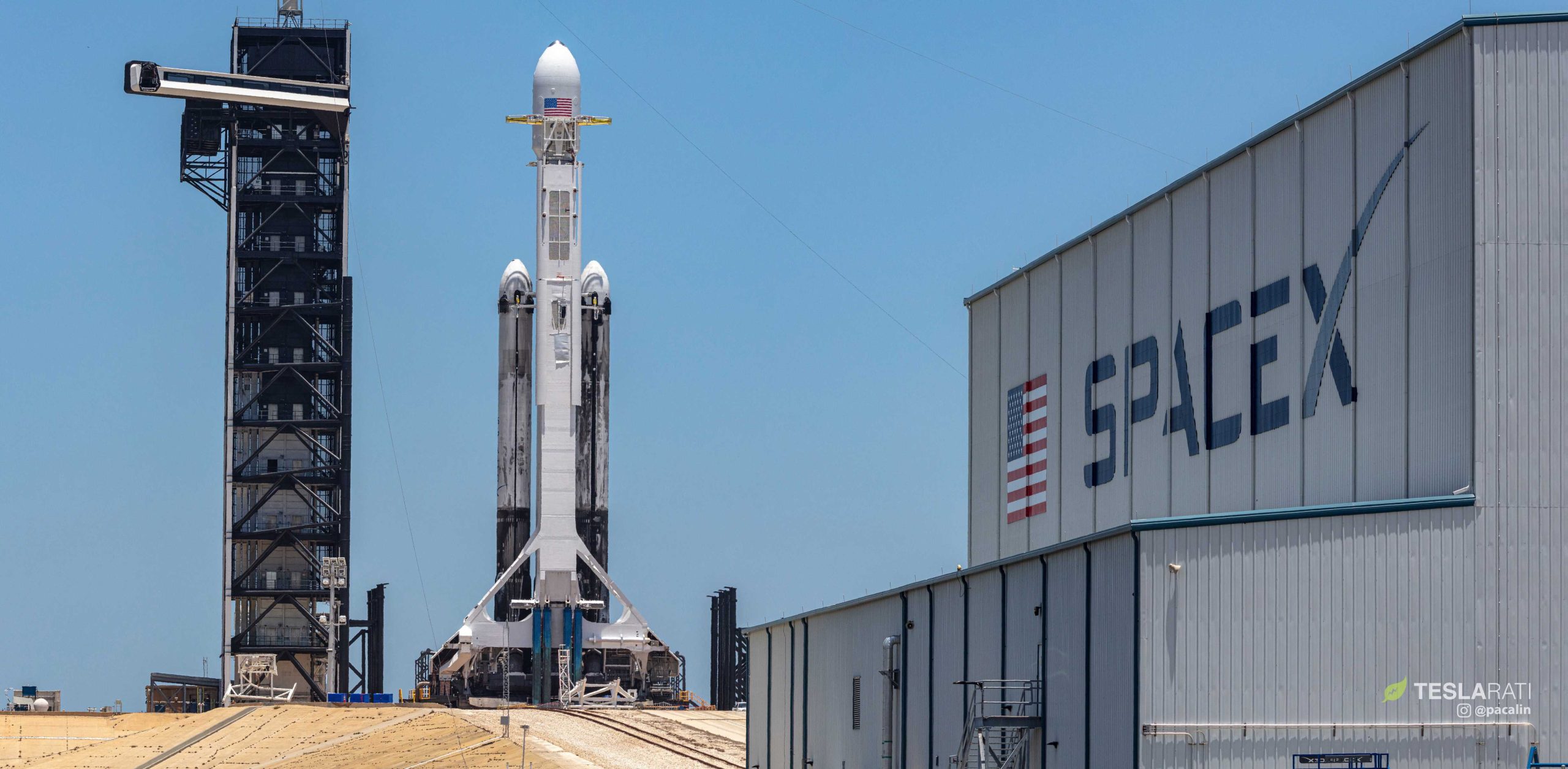
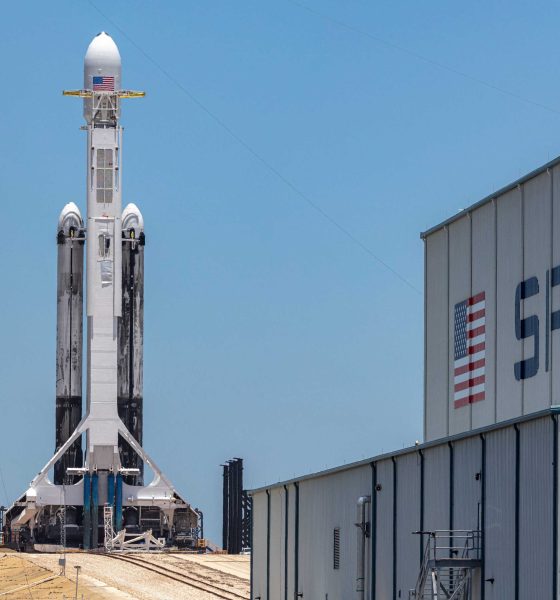
News
SpaceX's Falcon rockets might need a giant tower on wheels for US military launches
SpaceX reportedly plans to build a massive mobile gantry – effectively a tower on wheels – at one of its two Florida launch pads, a bid to meet obscure military launch criteria needed to secure highly lucrative Falcon 9 and Falcon Heavy launch contracts from the US government.
Although this is not the first time that SpaceX and vertical integration have been thrown around in the same sentence, it is the first time that the company is reportedly close to actually finalizing its plans along those lines and constructing a real solution at one or more of its three orbital-class launch pads.
Throughout the entirety of its active launch operations, SpaceX has relied exclusively on horizontal integration for its Falcon 1, 9, and Heavy rockets and the satellites they launch. CEO Elon Musk and other executives have maintained a consistent rationale for that preference over the years: ensuring that rockets and payloads can be horizontally integrated is the best possible solution so long as SpaceX’s primary motivation is improving access to space and lowering the cost of launch. As such, SpaceX has one and only one major motivation to jerry-rig a vertical integration solution for its Falcon family of rockets: necessity by way of arcane US military launch contract requirements.
Spaceflight Now broke the latest news first on January 3rd, 2020, revealing that SpaceX was at long last taking a substantial step towards actually building its own vertical integration infrastructure at Kennedy Space Center (KSC) Launch Complex 39A – a step that was long anticipated but has taken years to transpire into anything concrete. The gist is this: for a variety of seemingly shoehorned and far-from-obvious reasons, the secretive, ultra-expensive spy satellites that contractors like Lockheed Martin and Boeing build for the US Air Force (USAF) and the National Reconnaissance Office (NRO) builds itself are designed in such a way that they apparently cannot be flipped horizontally in a rocket’s payload fairing.
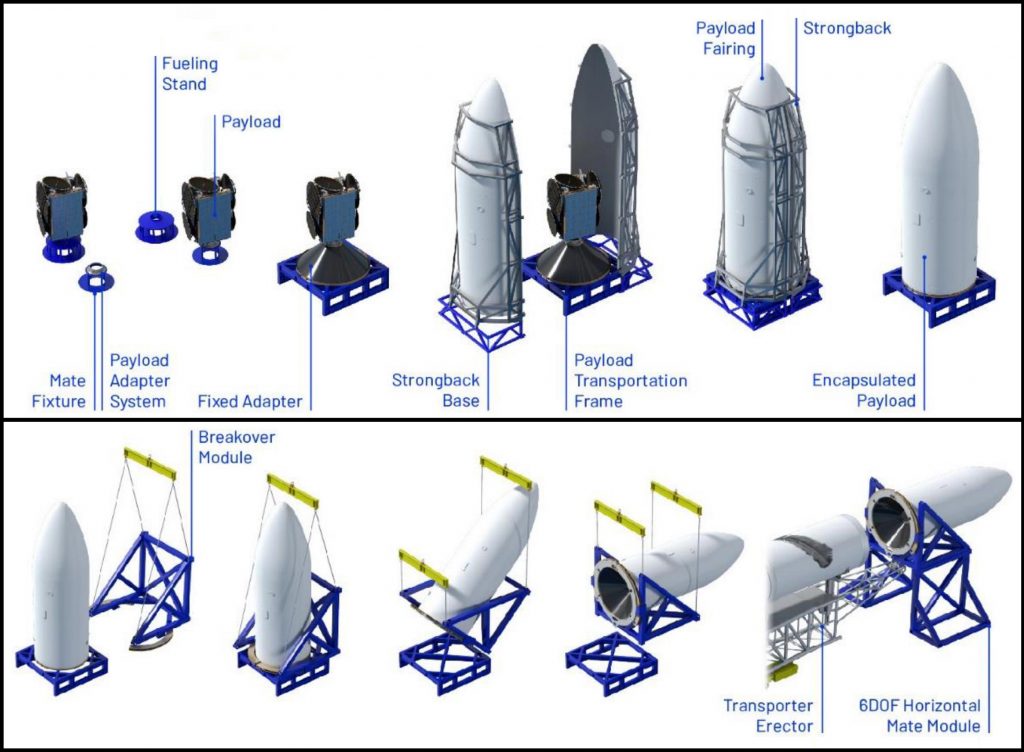
Identical to the process depicted above for Blue Origin’s in-development New Glenn rocket, up to now, SpaceX has encapsulated all satellite payloads vertically, sealed the payload fairing, rotated that integrated fairing and payload, and then attached that assembly to horizontal Falcon 9 and Falcon Heavy rockets. The rocket is then transported to the launch pad on a transporter erector (T/E), which – as the name suggests – raises the rocket and payload vertical before propellant loading and launch.
For certain USAF and NRO launch contracts, breakover (horizontal flip) is unacceptable and their preference is that the launch vehicle be brought vertical before the payload – also still vertical – is stacked on top. While it sounds simple in principle (i.e. “Just stick a crane out by the pad!”), vertical payload integration is exceptionally tedious unless you already have the infrastructure in place. Competitor United Launch Alliance (ULA), for example, already has that infrastructure – having held a decade-long monopoly over US military launches that only ended 5-7 years ago, depending on how it’s measured.
Both ULA’s Atlas V, Delta IV, and soon-to-be Vulcan Centaur rockets and the infrastructure used to launch them have all been designed around vertical payload integration – essentially requiring massive, expensive, and complicated buildings-on-wheels at each launch facility.
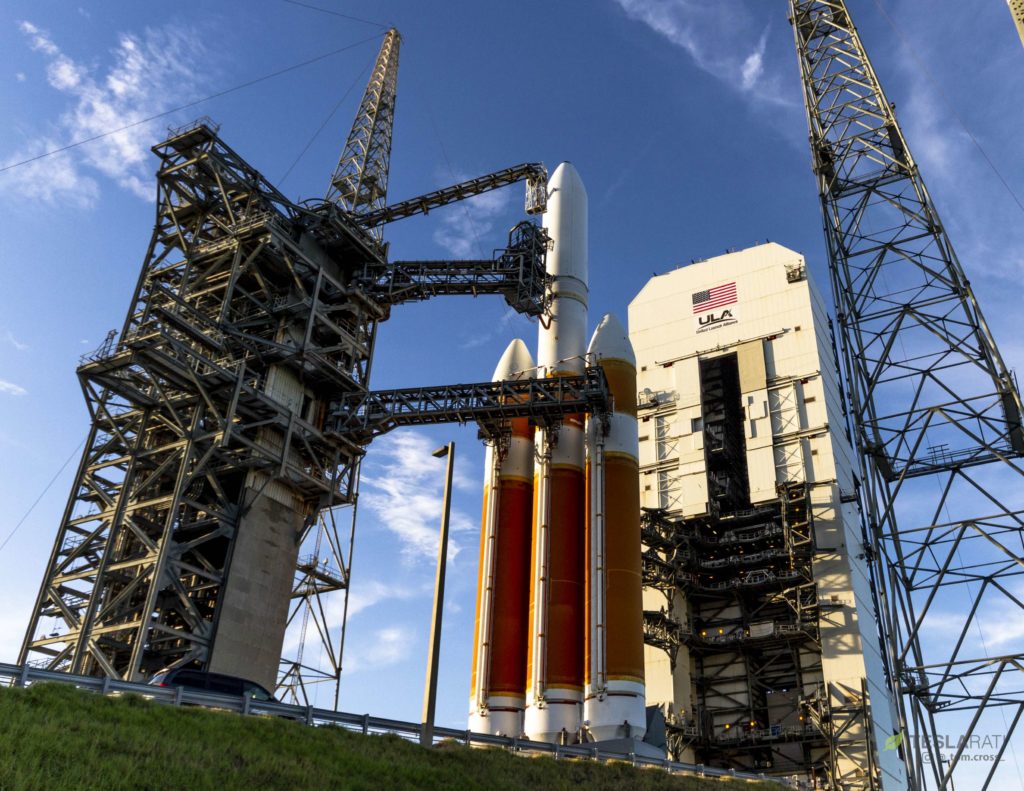
Per Spaceflight Now, SpaceX has plans to build a similar mobile tower at Pad 39A, currently dedicated Falcon 9/Crew Dragon missions for NASA and the occasional Falcon Heavy launch. That tower will ultimately roll up to Falcon 9 or Heavy rockets on the pad, fully covering the vehicles and giving technicians an array of work platforms and tools to support vertical payload integration, among other uses. SFN says that the mobile tower will be even taller than the existing Fixed Service Structure (FSS) tower at Pad 39A, measuring some 30 stories (100m/330ft) tall.
In line with a recent FSS redesign that saw that existing tower modified for Crew Dragon and outfitted with semi-transparent black glass or plastic and a black-and-white color scheme, the new mobile tower will apparently be built with a similar design language.
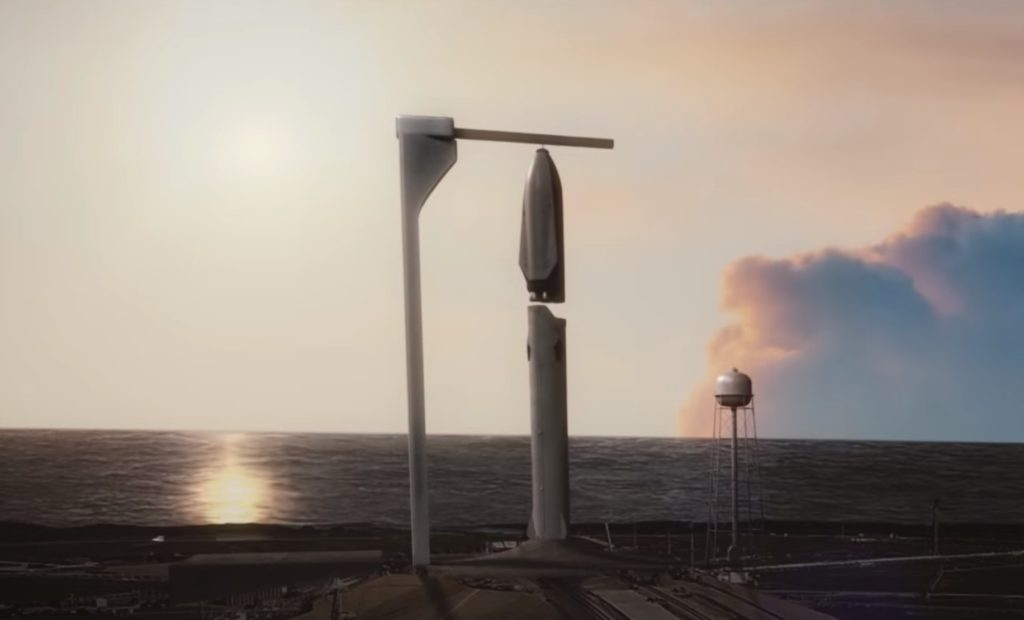
Ultimately, all of SpaceX’s plans for Starship – a massive next-generation, fully-reusable rocket – have relied on some form of vertical integration for Super Heavy boosters, Starships, and tankers. In a best-case scenario, all of those vehicles may one day land in reach of a giant crane situated at the launch pad, allowing SpaceX to lift them back to the pad and install ships and tankers on Super Heavy boosters just hours (maybe even minutes) after touchdown – truly rapid reuse.
For now, it’s unclear when exactly SpaceX wants to start cutting metal for its new Falcon 9/Heavy gantry, but it’s safe to say the company will move fast as usual once it begins.
Check out Teslarati’s Marketplace! We offer Tesla accessories, including for the Tesla Cybertruck and Tesla Model 3.

News
Tesla FSD fleet is nearing 7 billion total miles, including 2.5 billion city miles
As can be seen on Tesla’s official FSD webpage, vehicles equipped with the system have now navigated over 6.99 billion miles.

Tesla’s Full Self-Driving (Supervised) fleet is closing in on almost 7 billion total miles driven, as per data posted by the company on its official FSD webpage.
These figures hint at the massive scale of data fueling Tesla’s rapid FSD improvements, which have been quite notable as of late.
FSD mileage milestones
As can be seen on Tesla’s official FSD webpage, vehicles equipped with the system have now navigated over 6.99 billion miles. Tesla owner and avid FSD tester Whole Mars Catalog also shared a screenshot indicating that from the nearly 7 billion miles traveled by the FSD fleet, more than 2.5 billion miles were driven inside cities.
City miles are particularly valuable for complex urban scenarios like unprotected turns, pedestrian interactions, and traffic lights. This is also the difference-maker for FSD, as only complex solutions, such as Waymo’s self-driving taxis, operate similarly on inner-city streets. And even then, incidents such as the San Francisco blackouts have proven challenging for sensor-rich vehicles like Waymos.
Tesla’s data edge
Tesla has a number of advantages in the autonomous vehicle sector, one of which is the size of its fleet and the number of vehicles training FSD on real-world roads. Tesla’s nearly 7 billion FSD miles then allow the company to roll out updates that make its vehicles behave like they are being driven by experienced drivers, even if they are operating on their own.
So notable are Tesla’s improvements to FSD that NVIDIA Director of Robotics Jim Fan, after experiencing FSD v14, noted that the system is the first AI that passes what he described as a “Physical Turing Test.”
“Despite knowing exactly how robot learning works, I still find it magical watching the steering wheel turn by itself. First it feels surreal, next it becomes routine. Then, like the smartphone, taking it away actively hurts. This is how humanity gets rewired and glued to god-like technologies,” Fan wrote in a post on X.
News
Tesla starts showing how FSD will change lives in Europe
Local officials tested the system on narrow country roads and were impressed by FSD’s smooth, human-like driving, with some calling the service a game-changer for everyday life in areas that are far from urban centers.

Tesla has launched Europe’s first public shuttle service using Full Self-Driving (Supervised) in the rural Eifelkreis Bitburg-Prüm region of Germany, demonstrating how the technology can restore independence and mobility for people who struggle with limited transport options.
Local officials tested the system on narrow country roads and were impressed by FSD’s smooth, human-like driving, with some calling the service a game-changer for everyday life in areas that are far from urban centers.
Officials see real impact on rural residents
Arzfeld Mayor Johannes Kuhl and District Administrator Andreas Kruppert personally tested the Tesla shuttle service. This allowed them to see just how well FSD navigated winding lanes and rural roads confidently. Kruppert said, “Autonomous driving sounds like science fiction to many, but we simply see here that it works totally well in rural regions too.” Kuhl, for his part, also noted that FSD “feels like a very experienced driver.”
The pilot complements the area’s “Citizen Bus” program, which provides on-demand rides for elderly residents who can no longer drive themselves. Tesla Europe shared a video of a demonstration of the service, highlighting how FSD gives people their freedom back, even in places where public transport is not as prevalent.
What the Ministry for Economic Affairs and Transport says
Rhineland-Palatinate’s Minister Daniela Schmitt supported the project, praising the collaboration that made this “first of its kind in Europe” possible. As per the ministry, the rural rollout for the service shows FSD’s potential beyond major cities, and it delivers tangible benefits like grocery runs, doctor visits, and social connections for isolated residents.
“Reliable and flexible mobility is especially vital in rural areas. With the launch of a shuttle service using self-driving vehicles (FSD supervised) by Tesla in the Eifelkreis Bitburg-Prüm, an innovative pilot project is now getting underway that complements local community bus services. It is the first project of its kind in Europe.
“The result is a real gain for rural mobility: greater accessibility, more flexibility and tangible benefits for everyday life. A strong signal for innovation, cooperation and future-oriented mobility beyond urban centers,” the ministry wrote in a LinkedIn post.
News
Tesla China quietly posts Robotaxi-related job listing
Tesla China is currently seeking a Low Voltage Electrical Engineer to work on circuit board design for the company’s autonomous vehicles.

Tesla has posted a new job listing in Shanghai explicitly tied to its Robotaxi program, fueling speculation that the company is preparing to launch its dedicated autonomous ride-hailing service in China.
As noted in the listing, Tesla China is currently seeking a Low Voltage Electrical Engineer to work on circuit board design for the company’s autonomous vehicles.
Robotaxi-specific role
The listing, which was shared on social media platform X by industry watcher @tslaming, suggested that Tesla China is looking to fill the role urgently. The job listing itself specifically mentions that the person hired for the role will be working on the Low Voltage Hardware team, which would design the circuit boards that would serve as the nervous system of the Robotaxi.
Key tasks for the role, as indicated in the job listing, include collaboration with PCB layout, firmware, mechanical, program management, and validation teams, among other responsibilities. The role is based in Shanghai.
China Robotaxi launch
China represents a massive potential market for robotaxis, with its dense urban centers and supportive policies in select cities. Tesla has limited permission to roll out FSD in the country, though despite this, its vehicles have been hailed as among the best in the market when it comes to autonomous features. So far, at least, it appears that China supports Tesla’s FSD and Robotaxi rollout.
This was hinted at in November, when Tesla brought the Cybercab to the 8th China International Import Expo (CIIE) in Shanghai, marking the first time that the autonomous two-seater was brought to the Asia-Pacific region. The vehicle, despite not having a release date in China, received a significant amount of interest among the event’s attendees.








